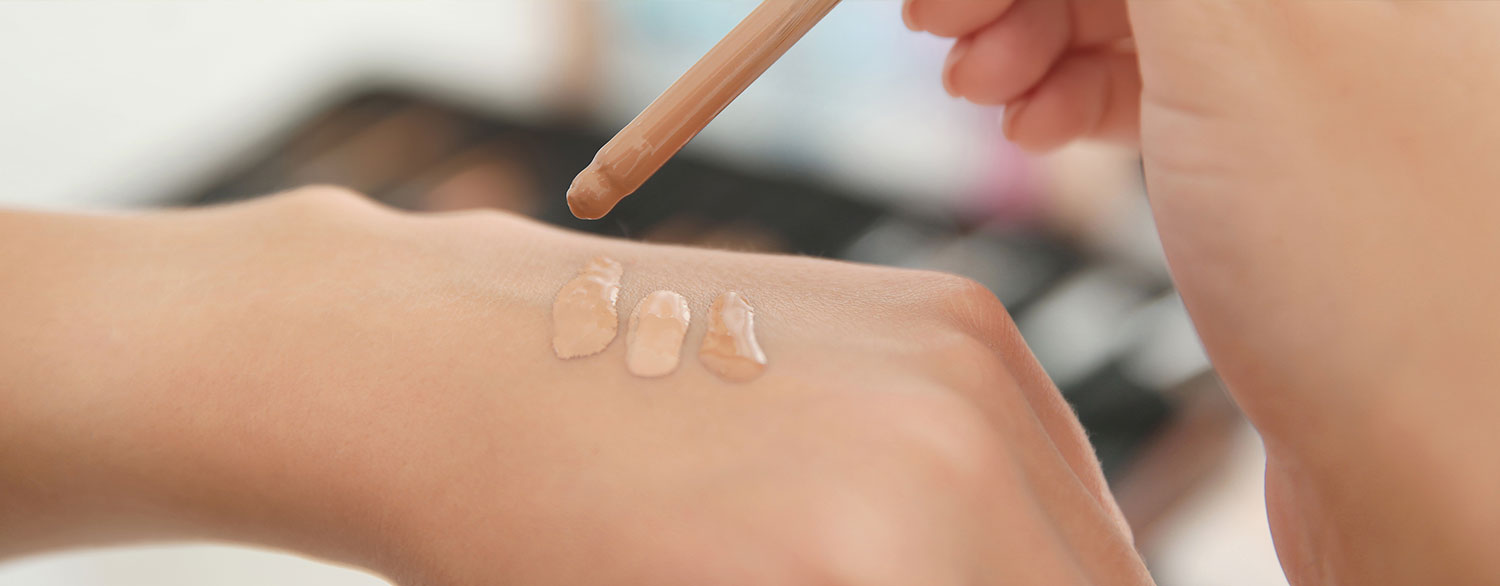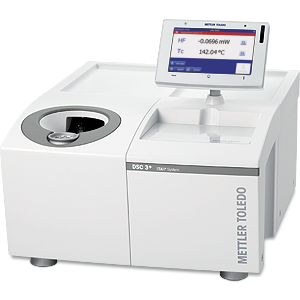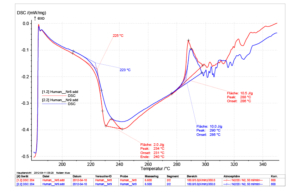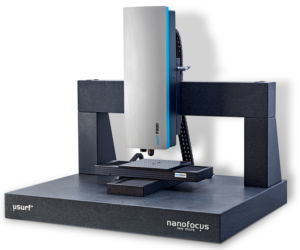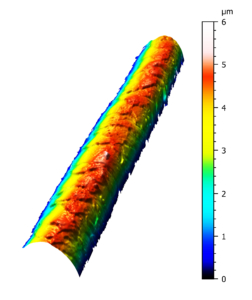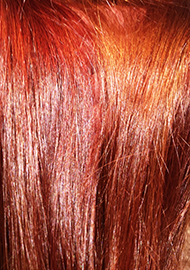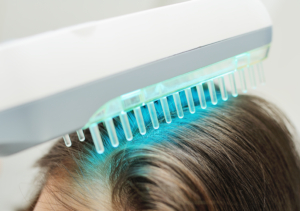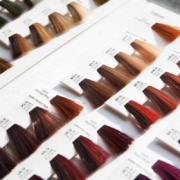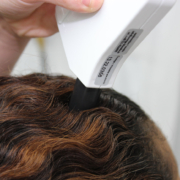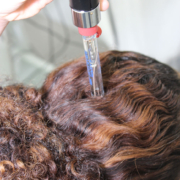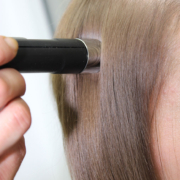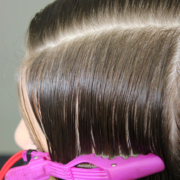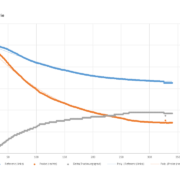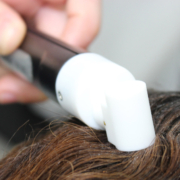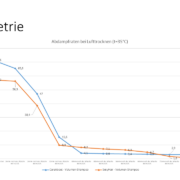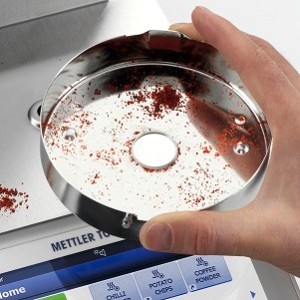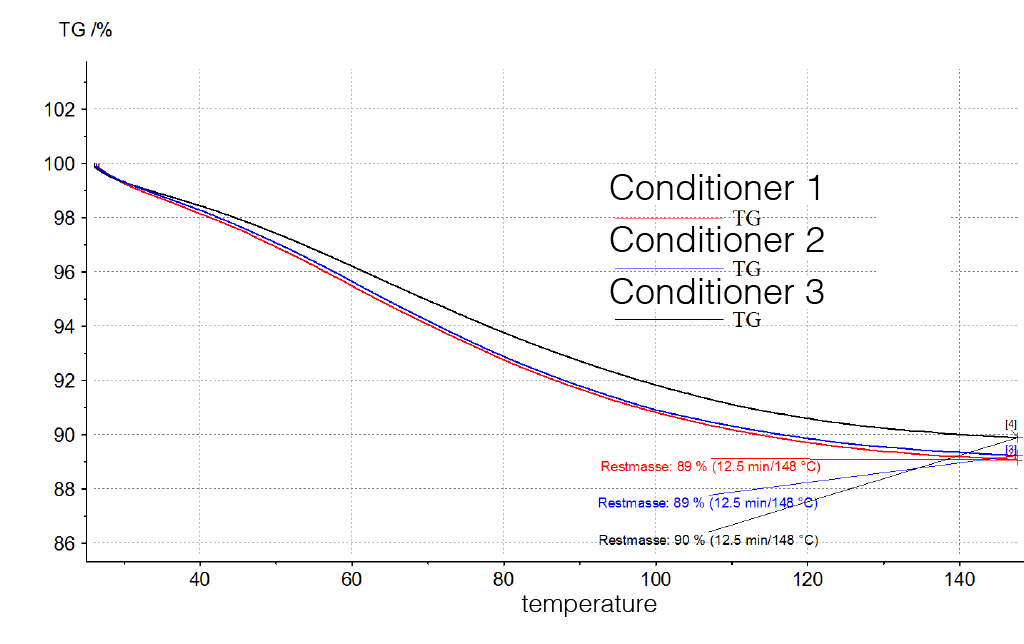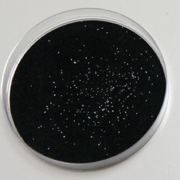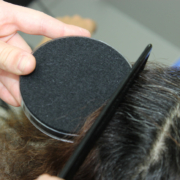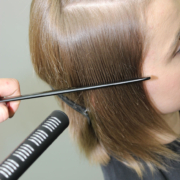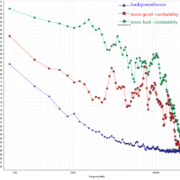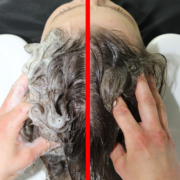De- und Restrukturierungen am Haar – Bestimmung durch dynamische Differenzialkalorimetrie
Die Bestimmung des Schmelzbereiches von Haaren ist eine Methode, über welche insbesondere innerstrukturelle Effekte am Haar erfasst werden können. Durch Bestimmen des Schmelzbereiches von Humanhaar lassen sich Rückschlüsse auf Re- und Destrukturierungen bedingt durch Haarbehandlungsmittel ziehen. Die Methode wird sowohl trocken als auch in wässrigen Medium (HP-DSC) angeboten.
Visualisierung von Oberflächen – Konfokalmikroskopie/Auflichtmikroskopie
Die digitale Auflichtmikroskopie liefert Visualisierungen der Oberflächenbeschaffenheit des Haares. Restrukturierungen sowie Destrukturierungen der Cuticula können visuell veranschaulicht werden.
Ergänzt wird diese Visualisierung durch die Konfokalmikroskopie. Schichtweise Fokusaufnahmen mit diesem Verfahren liefern durch Fusion der Einzelbilder eine 3D-Darstellung, welche
- die genaue Vermessung des Haares als echte mathematische Information bezüglich der Haardicke im gesamten sowie Vermessungen von Oberflächeneffekten ermöglichen (Rauhigkeitsbestimmung).
- den 3D-Druck einer Haarplastik ermöglichen, welche die Effekte an der Oberfläche zum Anfassen nahebringen.
Waschbeständigkeit von Haarfarben
Sowohl Standard-Strähnen als auch entnommenes Probandenhaar stehen als Matrix für Waschechtheitsbestimmungen zur Verfügung. Als Methode wird eine Standard-Ultraschall-Haarwäsche eingesetzt. Sowohl in vivo als auch in vitro werden dabei LAB-Bestimmungen vorgenommen und weiterhin durch standardisierte Probanden-Fotografie zur weiteren Visualisierung ergänzt. Dadurch lässt sich eine Aussage über die Waschechtheit von Haarfarbbehandlungsmitteln als Funktion der Zeit treffen.
UV-Beständigkeit von Haarfarben
Sowohl Standard-Strähnen als auch Probandenhaar (1/2-seitig) stehen als Matrix für Lichtechtheitsbestimmungen zur Verfügung. Nach Standard-Bestrahlung werden sowohl in vivo als auch in vitro LAB-Bestimmungen vorgenommen und weiterhin durch standardisierte Probanden-Fotografie zur weiteren Visualisierung ergänzt. Somit lässt sich eine Aussage über die Lichtechtheit von Haarfarbbehandlungsmitteln als Funktion der Zeit treffen.
Einordnen von Farbausfällen im Farbraum
Nach Standard-Applikationen von Haarfarbbehandlungsmitteln werden durch LAB-Messungen die Farbausfälle im Farbraum eingeordnet. Die gewonnenen Daten können sowohl für QM-Prozesse als auch zur Erstellung von Color-Boards herangezogen werden. Der Datenpool kann sowohl in vitro als auch in vivo erstellt werden.
Fettgehaltbestimmung auf der Haut und an Humanhaar
Auf fotometrischer Basis kann der Fettgehalt auf Haar und Haut bestimmt werden. Dadurch können in vivo sowie in vitro Aussagen über das Nachfetten von Haut und Haar in Abhängigkeit von der Verwendung bestimmter Behandlungsmittel ad hoc oder als Funktion der Zeit getroffen werden. Hierbei wird zunächst eine Spezialfolie über einen definierten Zeitraum auf die Haut/Haar gebracht. Die lipophile Beschichtung der Folie trägt sich in Abhängigkeit von der Sebumquantität unterschiedlich ab und reagiert nicht auf Feuchtigkeit. Hierdurch lassen sich direkt nach der Applikation von Behandlungsmitteln sowie als Funktion der Zeit Aussagen über den Fettgehalt sowie das Nachfetten der Haare im Ansatz, den Längen und dem Spitzenbereich machen. Analog können ebenfalls Bestimmungen auf der Kopfhaut vorgenommen werden. Die induzierte Wert zeigt eine kalkulierte Fettmenge in g/cm2 an.
pH-Bestimmung an Humanhaar
Eine In-Vivo- und In-Vitro-Messelektrode erlaubt eine okklusionsfreie pH-Bestimmung auf Haut und Haar. Die Messung kann direkt am Probanden beispielsweise nach Colorationen oder Umformungen in einem pH-Messbereich zwischen 0 – 11 abgegriffen werden.
Glanzmessungen an Haut und Haar
Das in vitro sowie in vivo anwendbare Glossymeter basiert methodisch sowohl auf der Basis direkt reflektierenden Lichts als auch auf der Basis diffus reflektierten Lichts. Eine nicht planare Matrix (wie beispielsweise das Haar) kann somit in vivo eine Reflexionsmessung erfahren. Diese Reflexmessung am Probanden im Testsalon kann die sensorische Wahrnehmung des Parameters Glanz als Direktmessung ergänzen. Die Reflexion wird dabei als Glanzeinheit erfasst (GU-Einheit: 100 GU = volle Reflexion; 0 GU = keine Reflexion).
Moisture-Balance – Bestimmung durch Konduktometrie
Moisture-Balance von Haut und Haar ist ein in der Kosmetik häufig verwendeter Begriff, oft jedoch ohne fassbare Definition. Diesem Haar- und Hautparameter widmet das Kompetenzzentrum bpc laboratories besondere Aufmerksamkeit und macht ihn erfassbar: Validiert durch Thermogravimetrie, Karl-Fischer-Titration und Tewametrie, lässt sich über ein spezielles konduktometrisches Verfahren ein Moisture Index (MI) bestimmen, welcher als konkreter Wert eine Aussage über eine bessere oder schlechtere Feuchtigkeitsbalance einer Probe im Vergleich zu einer Referenz widerspiegelt.
Moisture-Balance – Bestimmung von Abdampfraten an Humanhaar
Über eine spezielle Tewameter-Sonde lässt sich die Abdampfrate von Wasser am Haar und an der Haut bestimmen. Dabei lassen sich Informationen über den Wassergehalt des Haares bzw. des Wasserverlustes gegenüber Umwelteinflüssen (z.B. Föhnen oder Glätten) in Abhängigkeit von Haarbehandlungsmitteln gewinnen. Bezüglich der Haut kann eine Aussage über den Wasserverlust der Haut oder applizierter Cremes/Lotionen getroffen werden. Somit lässt sich eine Aussage über die Beeinflussung der Moisture-Balance von Haut und Haar treffen. Der Induzierte Wert zeigt die Abdampfrate (R) in g/h/m*m an.
Moisture-Balance am Haar – Bestimmung durch Thermogravimetrie
Mithilfe der Thermogravimetrie, validiert durch Karl-Fischer-Titration, können insbesondere Rückschlüsse auf den Wasserverlust vom Haar gezogen werden, beispielsweise beim Föhnen oder Glätten. Die Methode ist in vitro eine wichtige Ergänzung zu In-Vivo-Methoden (Bestimmung von Moisture Balance), um Aussagen über wasserspeichernde Effekte am Haar zu treffen.
Die Methode dient weiterhin zur Ergänzung der Tewametrie-Methode sowie Konduktometrie-Methode zur Bestimmung einer Moisture-Balance am Haar.
Anti-Schuppen-Wirkung
Auf der Basis einer standardisierten Testsalonmethode werden Kopfhautschuppen quantitativ gesammelt. Diese werden anschließend mit einer speziellen, hochauflösenden Kamera aufgenommen und automatisch nach neun differenzierten Größenordnungen vermessen. Durch Anwendung von Anti-Schuppen-Präparaten lässt sich nicht nur eine quantitative, sondern auch eine qualitative Aussage über Schuppenbildungen machen.
Akustische In-Vivo-Kämmbarkeitsbestimmung
Eine der subjektorientiertesten Parameter ist die Kämmbarkeit als sensorische Wahrnehmung. Um diese zu erfassen, ist einerseits objektiv in vitro mit ausladendem messtechnischem Aufwand oder andererseits eine reine sensorische Wahrnehmung eines Salontesters möglich.
Um diese Diffusionslücke zwischen In-Vitro- und In-Vivo-Methode zu schließen, hält das bpc laboratories Kompetenzzentrum eine Spezialmethode vor: In-Vivo-Kämmbarkeiten werden durch Richtmikrophone unter sensiblen Standardbedingungen monografisch abgegriffen. Das über einen standardisierten Zeitraum abgegriffene akustische Signal (Wellenform) wird über den Algorithmus der schnellen Fourier-Transformation als Spektogramm dargestellt. Hierbei lassen sich nun Geräusche frequenzbezogen darstellen. Die Methode kann parallel zur sensorischen Beurteilung der Kämmbarkeit in vivo eingesetzt werden und eine Bandbreite von bis zu 18kHz abgreifen. Durch eine erweiterte Sequenzanalyse lässt sich ein Combing-Determination-Index (CDI) bestimmen, welcher eine konkrete Aussage über eine bessere oder schlechtere Kämmbarkeit einer Probe im Vergleich zu einer Referenz als einheitsloser Wert widerspiegelt.
Bestimmung von Schaumeigenschaften
Eine Salon-Test-Beurteilung von Shampoos, Duschbädern sowie Rasierschaum liefert im Rahmen einer subjektiven Erhebung praxisnahe Daten bezüglich Reinigungs- und Konditionierungseigenschaften. Als ergänzende Betrachtung dienen dabei auflichtmikroskopische Analysen, die bildlich Schaumanspringverhalten, Schaumstabilität, Schaumqualität und Schaumstruktur erfassen. Anhand der auflichtmikroskopischen Einordnung des Schaums ergibt sich eine Relation zu den gewonnenen Informationen aus sensorischen Salon-Test.

